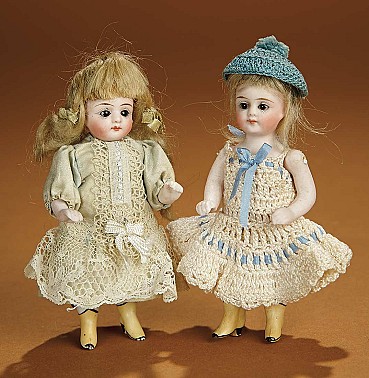Outstanding and All-Original French Musical Automaton "Pifferari" by Jean Roullet
Lot #56
32" (81 cm.) Standing upon a velvet-covered base is a bisque-head man with portrait-like regal, yet serene, expression, brown glass paperweight eyes, richly-painted lashes and brows, shaded nostrils, closed mouth with exquisitely shaded and outlined lips, separately modeled ears, brunette mohair wig, carton torso and legs, and paper mache hands which are posed to pluck the strings of the grand Celtic harp which he stands behind. Condition: generally excellent, mechanism and music function well. Marks: Depose Tete Jumeau 10 Bte SGDG (head). Comments: Jean Roullet, circa 1875, the automaton, named Pifferari, appeared as number 191, in the early Roullet catalog. It was priced in the luxury class at 125 francs. Pifferari, Italian performers of bagpipes and Celtic harp, were romanticized in 19th century France, ranging from an 1861 piano solo by Charles Gounod to this fantastical musical automaton. When wound, the man turns his head in nodding and circular motions as though in tune with the music, while his hands, independently of each other, roam up and down the strings; there are four movements and two musical tunes. Value Points: a very rare luxury automaton in wonderfully-preserved all-original condition, the performer is wearing an elaborate traditional Pifferari costume of ivory satin baggy pants and shirt, rose silk vest with matching capelet each trimmed with gold braid, matching coin purse, ruffled lace cuffs and collar, aqua silk cap with feathered detail and gold braid, a long aqua satin cape, and wonderful knee-high laced leather boots. The superb portrait face, very detailed original costume and accessory pieces, and its large size were further indications of its upscale status and its rarity.
























































































































































































































































































































































































































































